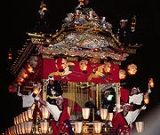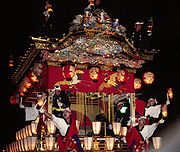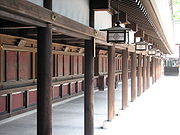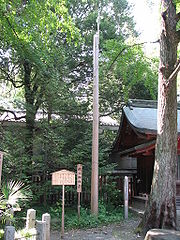
Chichibu Shrine
Encyclopedia



Chichibu, Saitama
is a city in Saitama, Japan. As of April 1, 2011, the city has an estimated population of 68,701, with a household number of 26,230. The total area is 577.69 km²....
, Saitama Prefecture
Saitama Prefecture
is a prefecture of Japan located in the Kantō region of the island of Honshu. The capital is the city of Saitama.This prefecture is part of the Greater Tokyo Area, and most of Saitama's cities can be described as suburbs of Tokyo, to which a large amount of residents commute each day.- History...
, Japan
Japan
Japan is an island nation in East Asia. Located in the Pacific Ocean, it lies to the east of the Sea of Japan, China, North Korea, South Korea and Russia, stretching from the Sea of Okhotsk in the north to the East China Sea and Taiwan in the south...
. The shrine is devoted to Yagokoro-omoikane-no-mikoto, Chichibuhiko-no-mikoto, and Ame-no-minaka-nushi-no-kami, and also enshrines Prince Chichibu
Prince Chichibu
, also known as Prince Yasuhito, was the second son of Emperor Taishō and a younger brother of the Emperor Shōwa. As a member of the Imperial House of Japan, he was the patron of several sporting, medical, and international exchange organizations...
.
According to text in the Sendai Kuji Hongi (Kujiki
Kujiki
, or , is a historical Japanese text. It was generally believed to have been one of the earliest Japanese histories until the middle of the Edo period, when scholars such as Tokugawa Mitsukuni successfully contended that it was an imitation based on the Nihon Shoki, the Kojiki and the Kogo Shūi...
), Chichibuhiko-no-mikoto, the tenth-generation descendant of the Kuni no miyatsuko
Kuni no miyatsuko
Kuni no miyatsuko were officials in ancient Japan at the time of the Yamato court.They were in charge of provinces , although it is not always very clear what those provinces were...
of Chichibu Province, established the shrine in the tenth year of Emperor Sujin
Emperor Sujin
; also known as Mimakiiribikoinie no Sumeramikoto or Hatsukunishirasu Sumeramikoto; was the tenth emperor of Japan, according to the traditional order of succession....
to worship Yagokoro-omoikane-no-mikoto.
During the Kamakura period
Kamakura period
The is a period of Japanese history that marks the governance by the Kamakura Shogunate, officially established in 1192 in Kamakura by the first shogun Minamoto no Yoritomo....
, the shrine merged with a neighboring temple, and was known as Myōken-gū until the separation of Shinto and Buddhism (Shinbutsu bunri
Shinbutsu Bunri
The term in Japanese indicates the forbidding by law of the amalgamation of kami and buddhas made during the Meiji Restoration. It also indicates the effort made by the Japanese government to create a clear division between native kami beliefs and Buddhism on one side, and Buddhist temples and...
). In the Meiji period
Meiji period
The , also known as the Meiji era, is a Japanese era which extended from September 1868 through July 1912. This period represents the first half of the Empire of Japan.- Meiji Restoration and the emperor :...
it took the name Chichbu Shrine, with the characters 知知夫神社 appearing on the tablet of the torii
Torii
A is a traditional Japanese gate most commonly found at the entrance of or within a Shinto shrine, where it symbolically marks the transition from the profane to the sacred...
.
The shrine hosts a number of events. The rice-planting festival takes place annually on April 4. The mid-summer Kawase Festival is celebrated on July 19 and 20. The Banba-machi Suwa Shrine festival is not annual, but occasional. It resembles the Onbashira
Onbashira
Onbashira is a festival held every six years in the Lake Suwa area of Nagano, Japan. The purpose of the festival is to symbolically renew the Suwa Taisha or Suwa Grand Shrine. "Onbashira" can be literally translated as "the honored pillars"....
festival of the Suwa Taisha
Suwa Taisha
, or Suwa Grand Shrine, is a Shinto shrine in Nagano prefecture, Japan. Over 1200 years old, it is one of the oldest shrines in existence, and is mentioned in the Kojiki, an 8th century text...
.
Chichibu's annual night festival draws the biggest crowds. Celebrated in December, it spans the first six days of the month. The parading of floats is listed as part of the national cultural heritage.
The national government has also recognized the shrine's sacred dance (kagura
Kagura
- Fictional characters :*Kagura Tsuchimiya, the protagonist of Ga-rei*Kagura, an InuYasha character*Kagura Sohma , a Fruits Basket character*Kagura, an Azumanga Daioh character*Ten'nōzu Kagura, a Speed Grapher character...
) as an important cultural asset. Similar honors have been awarded to its festival music, the floats, buildings and other possessions.
The shrine's grounds include a number of subsidiary shrines. A Tenjin Shrine
Tenman-gu
is a shinto shrine which enshrines Sugawara no Michizane as Tenjin. There are about 14 thousand Tenman-gū in Japan. Famous Tenman-gū are as follows.*Dazaifu Tenman-gū -- One of the Sōhonsha of Tenman-gū....
, Tōshō-gū, and a Suwa Shrine
Suwa Shrine
A is a shinto shrine part of the shrine network headed by Suwa Taisha. There are many Suwa Shrines in Japan. Famous Suwa Shrines are as follows.*Suwa Taisha -- Sōhonsha of Suwa Shrines.*Suwa Shrine *Suwa Jinja *Akita Suwa Gū...
are among them.
Source
This article incorporates material translated from 秩父神社 (Chichibu Jinja) in the Japanese Wikipedia,translated on August 23, 2008.
External links
- 秩父神社 (Chichibu Jinja), official web site

